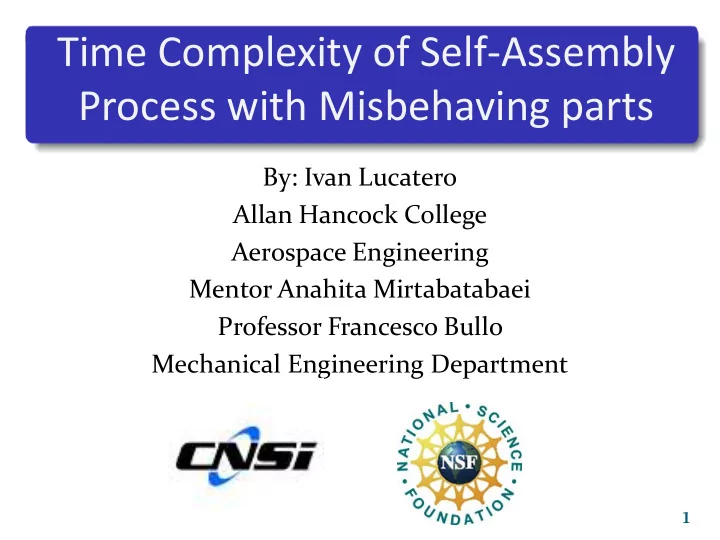

Time Complexity of Self-Assembly Process with Misbehaving parts By: Ivan Lucatero Allan Hancock College Aerospace Engineering Mentor Anahita Mirtabatabaei Professor Francesco Bullo Mechanical Engineering Department 1
What is Self Assembly? DNA Strand Self-Assembly consists of • Assimilating reactions in nature • Autonomous parts • Localized programming Future Robotics Chemical Reaction 2
Research Goals • Simulate biological system with Matlab/Simulink • Simulation is to include: • Time complexity • Misbehaving Parts • Effects on evolution time • Similarity to Initiator 3
Approach to Development of Code • Conditional programming • Parts’ size identification • Collision detection 4
Simulink Code Control of motion Distance to walls 5
Simulink Trial No collision detection • Code gets very long with • addition of parts No attaching mechanism • 6
Matlab Editor Programming • Less redundancy with use of loops • Data is readily accessible • Easy to vary number of parts • Very illustrative parts 7
Focused on Biomolecular Self-Assembly Metastable Three-arm Monomers junction Catalyst First State Second State Third State 8
Matlab Programming First Trial Second Trial All parts bounce and none connect Parts connect in pairs 9
Final Trial 10
Graphs N vs. Time of Completion 70 60 50 Time (s) 40 30 20 10 0 2 4 6 8 10 12 14 16 18 20 22 24 26 28 30 32 34 36 38 40 -10 N (Number of Parts) Number of Connections vs. Time 30.0 25.0 20.0 15.0 10.0 5.0 0.0 0 20 40 60 80 100 11 Time (s)
Future plans • Make code more user friendly • More complex shapes • Include more details 12
References http://www.symbrion.eu/show_image.php?id=5&scalesi ze=o Eric Klavins “Programmable Self Assembly” IEEE Control Systems Magazine » August 2007 Paolo Di Prodi, Lorenzo Cococcia, Matlab Code http://www.nature.com/nature/journal/v451/n7176/extr ef/nature06451-s1.pdf 13
Thank You First State Second State Third State Any Questions? DNA Strand 14
Misbehaving Parts Does not attach Destroys all bonds 15
Recommend
More recommend